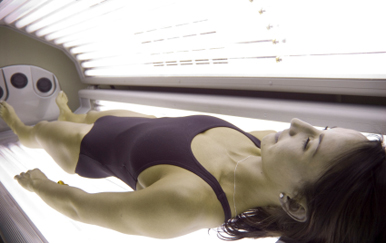The Darker Side of Tanning Salons
It is a misconception that tanning beds are safer than natural sunlight — they emit three times the UV radiation of the sun.

These days it seems as if a new tanning salon is popping up on every corner — especially near BU, since tanning salons are popular with college students seeking that year-round glow. But there is a darker side to tanning beds, which emit dangerous amounts of ultraviolet radiation that are three times more powerful than the sun, says Alan Geller (SPH’90), a School of Medicine research associate professor of dermatology and of epidemiology at the School of Public Health.
Despite years of research attesting to the harmful effects of tanning, many people still think that tanning beds are safer than natural sunlight because they emit mostly UVA radiation, sometimes called tanning rays, rather than UVB radiation, which is more closely associated with sunburns. UVA rays, however, are suspected of causing malignant melanoma, a deadly form of skin cancer. According to the Food and Drug Administration’s Department of Health and Human Services, the number of cases of melanoma is rising in the United States, which correlates with an increase in the use of tanning beds. An estimated 38,300 cases of melanoma and 7,300 deaths are anticipated this year.
“Melanoma, the most commonly fatal form of skin cancer, is the most common cancer among persons ages 25 to 29, so it is not something that one has to worry about only when one is much older,” says Geller. “The cancer crosses generations.”
An eight-year study of 100,000 Scandinavians, published in 2003 in the Journal of the National Cancer Institute, found that women of any age or skin tone who visit tanning salons more than once a month are 55 percent more likely to develop malignant melanoma. The study also reported an increased risk for developing melanoma of approximately 150 percent for women in their 20s who frequent tanning salons compared to women who never used tanning beds. In many cases, tanning bed use begins in high school and quickly becomes an addiction for some girls.
“We know that about 35 percent of 17-year-old girls use tanning beds, and we know that among those who use them, at least 40 percent use them more than 10 times per year,” says Geller. “The World Health Organization has just strongly recommended that use be prohibited for persons less than age 18, and this stems from recent studies showing the 55 percent increase in melanoma for frequent tanning bed users compared with nonusers.”
Despite the known and deadly risk of tanning, it remains popular among young women, and even some men. The desire for a bronzed look outweighs the dangers for many people.
“The tanning bed industry is now more than a $5 billion industry and is very savvy as to where to place salons — many of them are close to college campuses,” says Geller. “There are more salons because there is more of a market for them. Users want to look tanned and are prepared to burn a little to get a tan.”
But for some, tanning is about more than just looking good. It can become an addiction, Geller says, and can lead to other dangerous behaviors. “Some people are addicted to tans, and others visit tanning salons to look good and for warmth and relaxation during colder months,” he says. “We now also have evidence that frequent tanning bed users are more obsessed with body image, for example, and are more likely to use laxatives to control their weight than people who do not use tanning beds at all.”
Meghan Noé can be reached at mdorney@bu.edu.